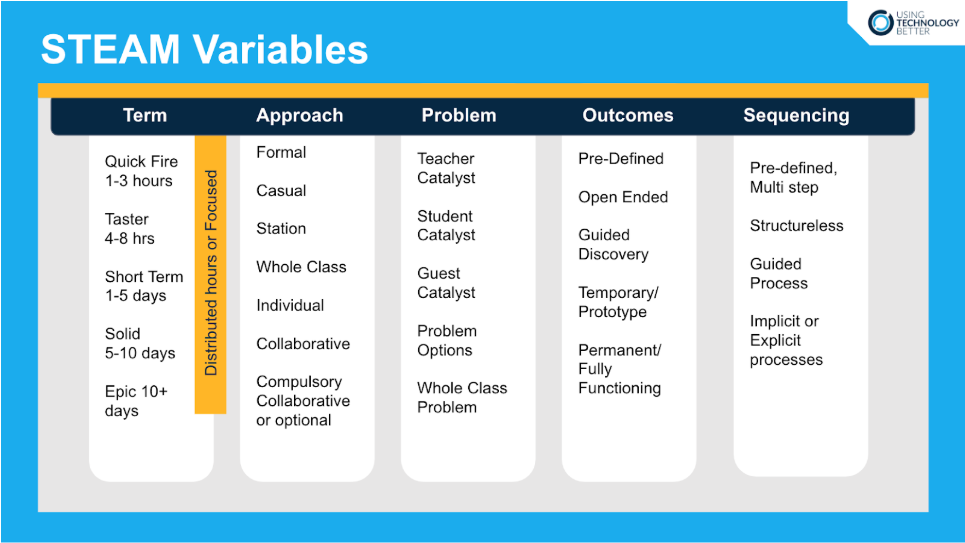Do you find yourself wondering what other schools are doing with STEAM? Have you started STEAM in your school but feel like you don’t know what it should look like?
The answer, rightly so, is that STEAM looks quite different from school to school. With unique communities and local curriculum, there is no one size fits all approach.
But do not despair!
In this post I am going to explain why you should invent your own version of STEAM and provide you with a ‘menu’ of what it could look like.
Why no ‘one size fits all’ approach?
Here at Using Technology Better, we pride ourselves on supporting schools to instigate change that aligns with their school values and vision. We believe STEAM and Digital Fluency initiatives should be built to support the students and communities needs. STEAM is often a catalyst to redesign a local and future-focused curriculum. While there are certainly common needs amongst schools, such as the necessity to equip students for a digital future where collaboration and creativity are necessary, there are also unique attributes. These attributes either need to be addressed or can be harnessed to facilitate authentic learning contexts.
[bctt tweet=”Make STEAM learning specific to your student’s needs #utpSTEAMpd” username=”MrTTHATCH”]
Why can’t STEAM just be teaching robots? Why should it be local?
STEAM is not just about learning how robots work or how to build a bridge. STEAM is a transdisciplinary approach to teaching which seeks to synthesise several key foci:
- Prepare students for the future
- Increase understanding of curriculum
- Increase engagement
- Develop a growth mindset
- Solve non-Googleable problems
Note: Each school should have their own list of ‘Why’s’ for STEAM and this may differ from mine
However, schools and their learners might have other foci that should be integrated into a STEAM approach, such as:
- Other ‘soft skills’ i.e empathy, resilience
- Mental health
- Cultural and spiritual empowerment
- Positive relationships
- Special needs
- Sustainability
As some of these areas are under supported by the government it is often critical schools integrate them into their STEAM or Digital Technologies initiatives. Therefore often the integration of STEAM has a driving question such as: ‘How can STEAM get our students ‘future ready’ while also culturally empowering them?’.
But what could it look like?
While the overall vision of STEAM should be developed through community consultation and integrated carefully into your school there are some clear variables which can be helpful to have as a discussion point. At my previous school, I developed a list of ‘STEAM Variables’ based on extensive research on schools that were already ‘doing’ STEAM.
This list of variables supports the founding conversations on what STEAM could look like at your school and helps to fast track implementation as it facilitates a modelling process, allowing you to critically consider variables before you start.
Simply combine various variables and you will have a clear set of ingredients for the format of your STEAM projects.
The STEAM Variables
The variables below are by no means extensive and if you would like to explore more variations please reach out. You might notice that the list is also intrinsically linked to Project Based Learning and you will also observe connections with the teacher and student capacity as well as school infrastructure and resources.
Underneath the STEAM Variables I have given a brief description of each element, but if you would like a fuller explanation be sure to check out some of the options at the bottom of this post.
[bctt tweet=”The #UTBPD STEAM variables list will help you fast track STEAM in your school #utbSTEAMpd” username=”MrTTHATCH”]
Term
How long will the STEAM project last for? Naturally the longer the STEAM project the more integrated it will be in your curriculum. Schools who run short term STEAM projects often have STEAM running parallel or underneath a traditional curriculum.
Approach
While I default to STEAM projects being tackled in groups there is sometimes a rational or need for individual projects. Some secondary schools or universities still require students to complete an individual, unique project. Likewise, some students just like to work individually at times and while developing collaboration skills is important, so is the ability of the individual to self manage and indulge one’s passions.
STEAM projects can be delivered in a rigorous or more casual manner. Some teachers simply make a STEAM activity station where students can walk up and do a 30 minute STEAM activity while others deliver a purposeful Project Based Learning sequence.
Problem
STEAM normally addresses an authentic problem and there are numerous ways this can be engaged with. A teacher might give a whole class a problem in the form of a brief or they orchestrate a selection of problems that students can ‘opt’ into. Other times teachers facilitate students to identify and clarify a problem of their own or get in a guest speaker. The term authentic is used often for the latter and there needs to be another blog post on defining the term ‘authentic’.
Output
The output of STEAM projects is more often than not of a temporary, prototype nature. Stand at the gates of any primary school on the last day of the year and you will see young students struggling to carry piles of cardboard prototypes and popsicle stick mock-ups home to show their parents. These are STEAM but they are essentially a prototype, not a functional product. Some schools focus on getting students to produce functional, permanent outputs such as wearable and durable laser cut jewellery. It is important to note that we should not judge the nature of the physical output as the value is in the learning process.
[bctt tweet=”Value process not product in STEAM learning #utbSTEAMpd #utbpd” username=”MrTTHATCH”]
Sequencing
Sequencing refers to the way students are supported through their STEAM learning. The sequencing depends on the strategy or pedagogy or heutagogy the school or teacher has subscribed to. Inquiry models, Project Based Learning, Design Thinking etc all have a sequence which supports and places value on the process. Interestingly some schools follow a clear process implicitly while others are following one explicitly. In other schools, students are free to make things without pausing to reflect on process or outcomes. There are often clear parallels between the year level of a student and how explicit a sequence is. The more students progress with their learning the more they are able to manage a process.
So what does STEAM look like?
Consider the student’s needs, your capabilities and the available resources and infrastructure and define what STEAM should or could look like in your school. Use the variables to begin this discussion and clarify what STEAM will look like in your school.
Want to know more about STEAM?
Sign up to our new Getting Started with STEAM courses to gain even more insight. Or check out our STEAM Ready schools programme and let’s work together to deliver purposeful and meaningful STEAM.
[bctt tweet=”The #UTBpd Getting Started with STEAM courses will fast track STEAM in your school” username=”MrTTHATCH”]












